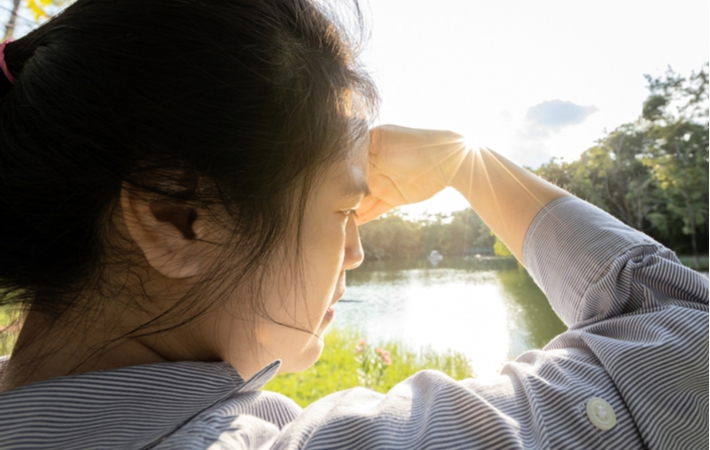We’ve all been caught outside on a sunny day without a pair of sunglasses.
The sun can quite literally be blinding. Not only are harsh glare and sunlight uncomfortable, but they can also cause temporary and permanent damage to your eyes.
If you’re regularly outdoors or exposed to UV light, it’s critical that you properly protect your eyes. Overexposure can lead to long-term issues with your eyes.
How Sun Exposure Affects Your Eyes
Like our skin, our eyes can be damaged by too much sun exposure. Sunlight produces ultraviolet light, or “UV” rays, which can cause temporary or permanent damage. After prolonged sun exposure, you may experience symptoms like:
- Headaches
- Red, teary eyes
- Temporary vision loss
- Irritation or discomfort
- Changes in colour vision
- Swelling around the eyes
- Blurred vision or light sensitivity
While these symptoms usually resolve on their own, extended sun exposure can cause photokeratitis, eye damage, and even blindness.
Types of UV Light
There are 2 types of UV radiation that can affect you, each with its own risks.
UVA
UVA is the lowest-energy UV radiation and accounts for 95% of the sun’s rays. UVA is associated with sunburns and tanning. While UVA isn’t directly linked to major eye or skin issues, it can damage the cornea (clear membrane in front of your eye).
UVA can still reach us through windows and cloud cover.
UVB
UVB can cause quick burns, tans, and even blistering. The intensity of UVB rays can change, but UVB rays can damage your eyes all year. UVB rays are particularly harmful at high altitudes or near highly reflective surfaces, such as water or snow.
UVB rays can be filtered.

What Is Photokeratitis?
Photokeratitis is a temporary eye condition that’s caused by overexposure to UV light. This condition is like a sunburn on your corneas.
If you’ve experienced snow blindness, this is a type of photokeratitis. Snow is a highly reflective surface that creates a harsh glare in the sun. If you’re not wearing sunglasses that filter UV rays, you can develop photokeratitis.
Fortunately, photokeratitis is temporary and your symptoms should go away within a few hours or days depending on the severity. You can also alleviate symptoms at home.
Treatment
If you experience any symptoms of prolonged UV exposure, go indoors right away. Stay in a darkened room and remove your contact lenses (if you’re wearing them). Avoid rubbing your eyes.
You may find it helpful to put a cold compress over your eyes, use artificial tears, or take a non-steroidal, anti-inflammatory drug (like Advil or Motrin).
If you experience any vision loss or prolonged pain, seek medical attention immediately.
Permanent Damage
In severe cases, prolonged sun exposure can cause long-term, permanent damage to your eyes and increase your risk of developing certain eye conditions.
Overexposure to UV rays can cause your eye to grow pterygium, an elevated growth across the sclera (white of your eye). These growths are non-cancerous, but can cause scarring on the cornea.
Chronic overexposure can also cause pinguecula, an abnormal growth, on the outermost tissue of the eye. These growths are raised, yellow, and close to the edge of the cornea.
Excessive sun exposure can also speed up the development of cataracts and macular degeneration. While you may not notice the damage today, overexposure to UV light can cause long-term, permanent damage to your eyes.
Know Your Risk
Excessive sun exposure can increase your risk of developing eye diseases and conditions, such as cataracts, glaucoma, and age-related macular degeneration. It’s important to always wear UV protective sunglasses. Polarized sunglasses can work, but it’s important that these lenses also have UV protection.
Cataracts
Cataracts are the clouding of the natural, normally clear lens inside your eye. Cataracts usually develop over time and can often be resolved with surgery. This condition is associated with blurry vision and “blind spots” in the central and peripheral visual fields.
Glaucoma
Glaucoma is a group of eye conditions that damage the optic nerve. It’s often caused by high pressure inside the eye. Vision loss from glaucoma is irreversible, so it’s important to go in for regular eye exams to detect early warning signs.
Age-Related Macular Degeneration
Age-related macular degeneration (AMD) is a disease that impacts central vision. While blindness is a rare side effect, AMD can impact a person’s ability to drive, read, and recognize faces. AMD can’t be cured, but early detection can help slow its progression.
Prevention
It’s easy to protect your eyes from harmful UV rays with the right methods. Most importantly, you should have a pair of sunglasses with lenses that have a UV protective coating. Polarized sunglasses work, too, as long as the lenses have UV protection included. Talk to your optometrist about the right lenses for your sunglasses.
UV Protection & Polarized Lenses
The most effective way to protect your eyes is by wearing proper eyewear, such as sunglasses or snow goggles. Sunglasses and goggles come with a UV protective coating that can block or absorb 99% to 100% of UV light.
These are highly recommended if you spend a lot of time outdoors. For UV protection, never buy a pair of glasses that are marked as less than 99%—it’s not worth your money. Polarized lenses offer protection from harsh glare, but not every pair has UV protection.
Other Methods
You can also protect your eyes by wearing wide-brimmed hats or visors outdoors. You should also ensure you have the proper eye protection for your work.
You can also talk to your optometrist about UV-absorbing contact lenses.
Most importantly, continue to schedule and attend regular eye exams to preserve your vision.
When to See Your Doctor
If you experience any changes in your vision or have questions regarding your eye health, contact our team today! We’re happy to help you.







